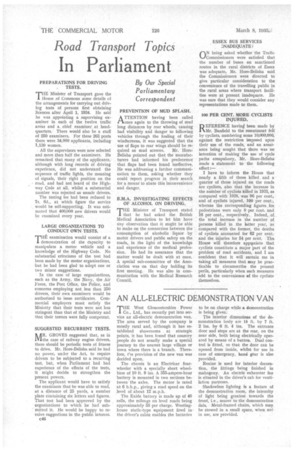Road Transport Topics
Page 70

If you've noticed an error in this article please click here to report it so we can fix it.
In Parliament
By Our Special Parliamentary Correspondent
PREPARATIONS FOR DRIVING TESTS.
THE Minister of Transport gave the 1 House of Commons some details of the arrangements for carrying out driving tests of persons first obtaining licences after April 1, 1934. He said he was appointing a supervising examiner in each of the twelve traffic areas and a , chief examiner, at headquarters. There would also be a staff of 250 examiners. For these 26a posts there were 34,000 applicants, including 1,130 women.
All the supervisors were now selected and more than half the examiners. He remarked that many of the applicants, although with long records of driving experience, did not understand the sequence of traffic lights, the meaning of signals, their right position on the road, and had not heard of the Highway Code at all, whilst a substantial number was rejected as unsafe drivers.
The testing fee had been reduced to 'Ts. (Id., at which figure the service would be self-supporting. It was estimated that 400,000 new drivers would be examined every year.
LARGE ORGANIZATIONS TO CONDUCT OWN TESTS.
'THE examination would consist of a 1 demonstration of the capacity to manipulate a motor vehicle and a knowledge of the Highway Code. No substantial criticisms of the test had been made by the motor organizations, but he had been glad to adopt one or two minor suggestions.
In the case of large organizations, such as the Army, the Navy, the Air Force, the Post Office, the Police, and concerns employing not less than 250 drivers, their own examiners would be authorized to issue certificates. Commercial employers must satisfy the Ministf y that their tests were not less stringent than that of the Ministry and that their testers were fully competent.
SUGGESTED RECURRENT TESTS.
AAR. GROVES suggested that, as in Inthe case of railway engine drivers, there should be periodic tests of fitness to drive. Mr. Hare-Belisha said he had no power, under the Act, to require drivers to be subjected to a recurring test, but, when Parliament had had experience of the effects of the tests, it might decide to strengthen the present powers.
The applicant would have to satisfy the examiners that he was able to read, at a distance of 25 yards, a number plate containing six letters and figures. That test had been approved by the organizations to which he had submitted it. He would be happy to receive suggestions in the public interest.
c46 PREVENTION OF MUD SPLASH.
A TTENTION having been called 1–konce again to the throwing of mud long distances by rear wheels, causing bad visibility and danger to following vehicles through the fouling of their windscreens, it was suggested that the use of flaps to rear wings should be re;
quired as mud screens. Mr. flore-: Belisha pointed out that the manufacturers had informed his predecessor that flaps had been found ineffective. He was addressing a further communication to them, asking whether they could report progress in their search for a means to abate this inconvenience and danger.
B.M.A. INVESTIGATING EFFECTS OF• ALCOHOL ON DRIVING.
THE Minister of Transport stated that he had asked the British Medical Association to let him have any observation that it might be able to make on the connection between the consumption of alcoholic liquor by motor drivers and public safety on the roads,. in the light of the knowledge and experience of the medical profession. He had its assurance that the matter would be dealt with at once. A special sub-committee of the Association was on that day holding its first meeting. • He was also in communication with the Medical Research Council.
ESSEX BUS SERVICES :NADEQUATE ?
C)N being asked whether the Traffic Commissioners were satisfied that the number of buses on sanctioned routes in the rural districts of Essex was adequate, Mr. Hore-Belisha said the Commissioners were directed to give particular consideration to the convenience of the travelling public in the rural areas where transport facilities were at present inadequate. He was sure that they would consider any representations made to them.
100 PER CENT. MORE CYCLISTS INJURED.
110 EFERENCE having been made by 11Mr, Banfield to the resentment felt by cyclists, numbering some 10,000,000, against the restriction imposed upon their use of the roads, and an assurance being sought that there was no intention of making the use of cycle paths compulsory, Mr. .Hore-Belisha made a statement to the following effect:—
I have to inform the House that nearly a fifth of those killed and a quarter of those injured on the roads are cyclists, also that the increase in the nuinbef of cyclists killed in 1933, as compared with 1928, was 96 per cent., and of cyclists injured, 100 per cents, whereas the corresponding figures foe pedestrians were only &per cent. and 16 per cent., respectively.. Indeed, of the total increase in the number of persons killed in the latter year, as compared with the former, the deaths. Of cyclists accounted for 62 per cent.. and the injuries for 54 per cent. The House will therefore app;eciate that cyclists constitute a major part of the problem of road accidents, and I am confident that it will sustain me in taking all measures that may be practicable to circumscribe the present perils, particularly when such measures add to the convenience of the cyclists themselves.














































































































